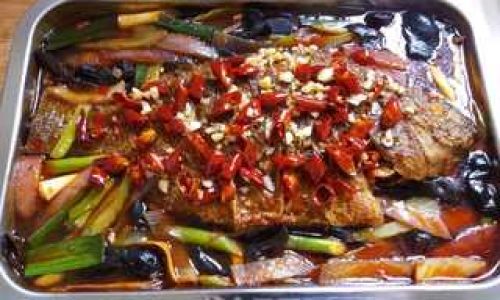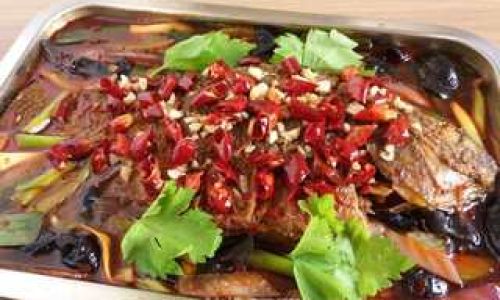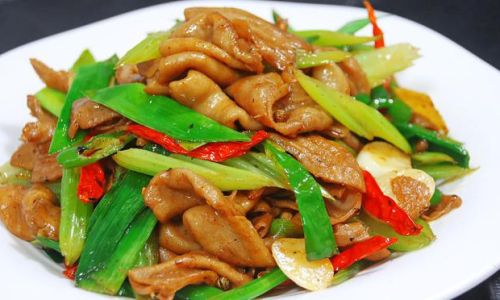Table of content
Braised crucian carp with scallions, or Cong Shao Ji Yu in Mandarin, is a beloved Chinese dish that marries delicate fish with aromatic scallions and a savory-sweet sauce. This recipe, rooted in traditional Chinese culinary techniques, highlights the balance of flavors and textures that define regional cuisines. Whether you’re a seasoned home cook or a novice in the kitchen, this guide will walk you through creating a restaurant-quality dish that impresses with its umami-rich broth, tender fish, and vibrant garnishes.
The Essence of the Dish
Crucian carp, a freshwater fish prized for its tender flesh and mild sweetness, is the star of this recipe. When braised, it absorbs the flavors of the sauce while retaining its delicate texture. Scallions, or green onions, serve a dual purpose: their white bulbs infuse the braising liquid with a subtle oniony aroma, while the green tops add a fresh, grassy note. The dish is further enhanced by ginger, garlic, soy sauce, and a touch of sugar, creating a harmonious blend of salty, sweet, and savory notes.

Ingredients You’ll Need
To recreate this dish authentically, gather the following ingredients:
- 2 medium crucian carp (about 1.5 lbs total), cleaned and scaled
- 1 bunch scallions (approximately 8–10 stalks), trimmed and cut into 3-inch segments
- 3-inch piece fresh ginger, peeled and thinly sliced
- 4 garlic cloves, minced
- 3 tbsp soy sauce (preferably light soy for saltiness)
- 1 tbsp dark soy sauce (for color)
- 2 tbsp Shaoxing wine (or dry sherry as a substitute)
- 1 tbsp sugar
- 1 tsp sesame oil
- 1 cup chicken broth (or vegetable broth for a vegetarian twist)
- 2 tbsp cooking oil (peanut or vegetable oil works best)
- 1 tbsp cornstarch (mixed with 2 tbsp water for slurry)
- Salt and white pepper to taste
- Optional garnishes: cilantro, red chili flakes, or sesame seeds
Step-by-Step Preparation
Preparing the Fish
- Cleaning: Rinse the crucian carp under cold water, pat dry with paper towels, and remove any remaining scales or internal organs. Use a sharp knife to make shallow diagonal cuts on both sides of the fish (about ½ inch apart). This allows the seasonings to penetrate the flesh and ensures even cooking.
- Marinating: In a bowl, combine 1 tbsp soy sauce, 1 tbsp Shaoxing wine, 1 tsp sugar, and a pinch of salt. Rub this mixture all over the fish, including the cavity. Let it marinate for 15–20 minutes while you prepare the other ingredients.
Prepping the Aromatics
- Scallions: Separate the white and green parts of the scallions. Slice the white bulbs into thin rings and chop the green tops into 2-inch segments.
- Ginger and Garlic: Julienne the ginger into thin strips and mince the garlic. Set aside.
Searing the Fish
- Heating the Pan: Place a large wok or skillet over medium-high heat. Add 2 tbsp of cooking oil and swirl to coat the pan.
- Searing: Once the oil shimmers, carefully place the marinated fish into the pan. Let it sear undisturbed for 3–4 minutes per side until golden brown. This step seals in the juices and prevents the fish from falling apart during braising.
- Removing the Fish: Transfer the seared fish to a plate and set aside.
Cooking the Aromatics and Sauce
- Sautéing: In the same pan, reduce the heat to medium. Add the sliced ginger and garlic, stirring constantly for 30 seconds until fragrant.
- Adding Scallions: Toss in the white parts of the scallions and cook for another minute until softened.
- Deglazing: Pour in the remaining 1 tbsp of Shaoxing wine, scraping the bottom of the pan to release any browned bits.
- Building the Sauce: Stir in the light soy sauce, dark soy sauce, sugar, and chicken broth. Bring the mixture to a simmer, then taste and adjust seasoning with salt and white pepper.
Braising the Fish
- Returning the Fish: Gently slide the seared fish back into the pan, nestling it into the sauce. Spoon the liquid over the fish to ensure even cooking.
- Braising: Cover the pan and reduce the heat to low. Let the fish simmer for 10–12 minutes, or until the flesh flakes easily with a fork. Baste the fish occasionally with the sauce to keep it moist.
Thickening the Sauce
- Cornstarch Slurry: Once the fish is cooked, remove it from the pan and transfer it to a serving platter. Increase the heat to medium and stir in the cornstarch slurry. Cook for 2–3 minutes until the sauce thickens to a glossy consistency.
- Final Touches: Drizzle the sesame oil into the sauce and stir in the green scallion segments. Let the sauce simmer for another minute.
Serving
- Plating: Pour the thickened sauce over the fish, ensuring it’s evenly coated. Garnish with cilantro, red chili flakes, or sesame seeds if desired.
- Pairing: Serve hot with steamed rice, jasmine rice, or noodles to soak up the flavorful sauce.
Tips for Perfecting the Dish
- Fish Selection: If crucian carp is unavailable, substitute with other freshwater fish like carp or sea bass. Avoid oily fish (e.g., salmon) as they may overpower the delicate sauce.
- Preventing Sticking: Ensure the pan is hot before searing the fish. A non-stick pan or well-seasoned cast-iron skillet works best.
- Scallion Strategy: Use the white parts for cooking and reserve the green tops for garnish to maintain their vibrant color.
- Sauce Consistency: Adjust the cornstarch amount based on your preference—add more for a thicker gravy or less for a lighter broth.
- Spice Variations: For heat, add a sliced red chili pepper when sautéing the ginger and garlic.
Cultural Significance
Braised crucian carp with scallions is a staple of Chinese home cooking, particularly in regions with access to freshwater fish. The dish symbolizes prosperity and abundance, making it a popular choice for festive occasions like Lunar New Year. The green scallions also represent vitality and growth, aligning with themes of renewal in Chinese culture.

Troubleshooting Common Issues
- Fish Breaking Apart: Overcooking or rough handling during searing can cause the fish to fall apart. Use a gentle spatula and avoid flipping it too soon.
- Bitter Sauce: Burnt garlic or ginger can impart bitterness. Sauté aromatics over low heat and remove them immediately if they start to brown.
- Too Salty: Balance the saltiness with a splash of water or a pinch of sugar.
Conclusion
Braised crucian carp with scallions is a testament to the beauty of simplicity in Chinese cuisine. With minimal ingredients and careful technique, you can create a dish that’s both comforting and elegant. Whether you’re cooking for a family dinner or impressing guests, this recipe is sure to become a cherished addition to your repertoire. So, gather your ingredients, embrace the sizzle of the wok, and savor the joy of crafting a timeless classic.





0 comments